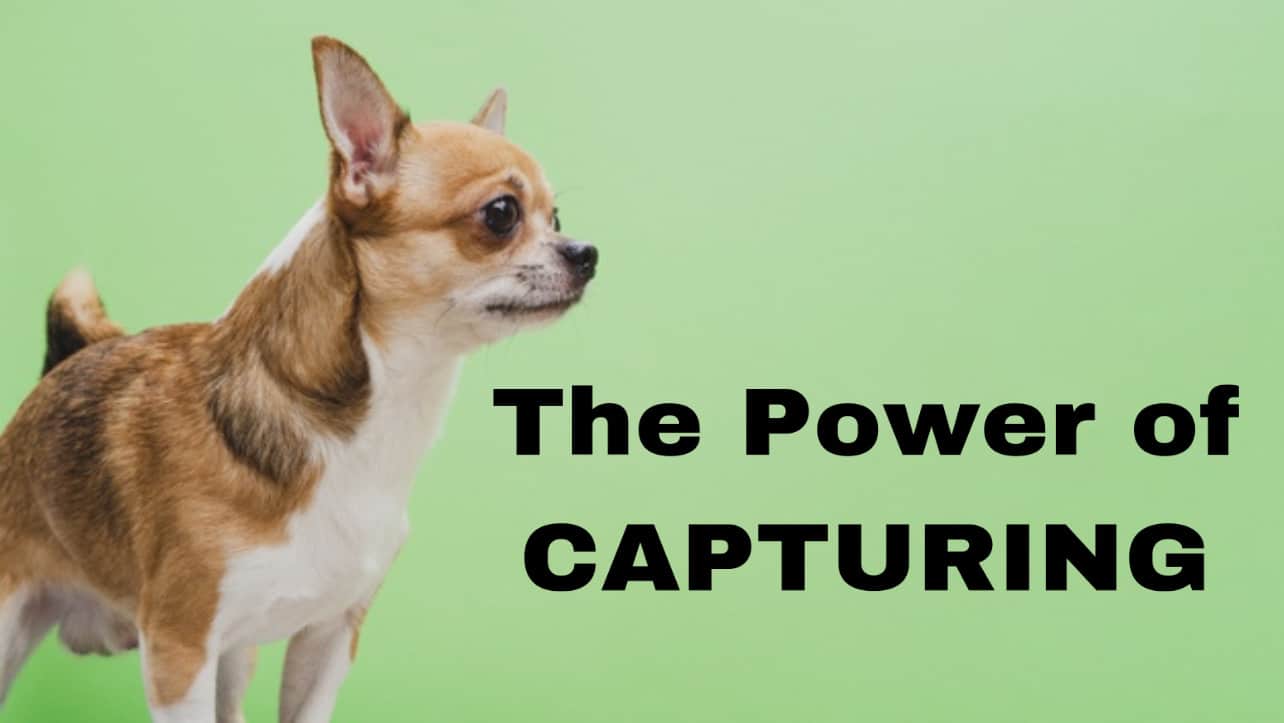Capturing, dog training, Puppy Training
Dog Training Using Capturing
By Will Bangura, M.S., CBCC-KA, CPDT-KA, (Dog Behaviorist,) Certified Behavior Consultant.
What is Capturing in Dog Training, and How Does it Work?
Capturing is a dog training technique that involves rewarding a dog for performing a specific behavior naturally. In other words, instead of teaching the dog the behavior, you wait for the dog to perform it independently and then reward the dog for doing so. This technique is based on the principle that if a behavior is rewarded, it is more likely to be repeated. When capturing, you use a marker word or clicker to signal to the dog that it has performed the behavior correctly, and then you reward the dog with a treat or praise.
Capturing can teach various behaviors, including basic commands like sit, lay down, come, and go potty, and more advanced behaviors like rolling over or high-fiving. The process of capturing can be broken down into three main steps: observing, marking, and rewarding.
Dog Training Using Capturing is about Observing.
The first step in capturing is to observe your dog and wait for it to perform the behavior you want to capture. For example, if you want to teach your dog to sit, you would wait for it to sit independently.
Dog Training Using Capturing involves Marking.
Once your dog performs the behavior you want to capture, you need to use a marker word or clicker to signal to the dog that it has performed the behavior correctly. This is important because it helps the dog understand which behavior is being rewarded. A common marker word is “yes,” but you can use any word or sound your dog can easily associate with a positive outcome.
Dog Training Using Capturing involves Rewarding.
After you have marked the behavior, you need to reward your dog with a treat or praise. The reward should be given immediately after the marker word or clicker, so the dog associates the behavior with the reward.
Benefits of Capturing, especially with young puppies.
Capturing has several benefits, especially when used with young puppies. First, it is a natural and non-invasive way to train a dog. Capturing does not involve physical manipulation or force, so it is less stressful for the dog and can be used with puppies as young as eight weeks old.
Second, capturing can be used to teach a wide variety of behaviors without the need for extensive training. This makes it a great technique for pet owners who do not have a lot of time or experience with dog training.
Finally, capturing is a great way to build a strong bond between the owner and the dog. When the dog performs a behavior naturally and is rewarded, it helps build a positive association with the owner. This can help create a stronger relationship and make training more enjoyable for the owner and dog.
Steps to Use to Capture Basic Commands.
Capturing is an effective way to train dogs and can be used to teach a variety of basic commands. The following are the steps to use to capture basic commands:
Training Sit Using Capturing.
To teach your dog to sit using capturing, follow these steps.
Observe your dog and wait for it to sit on its own.
Use a marker word such as “yes” or a clicker to signal the dog that it has performed the behavior correctly.
Reward your dog immediately with a treat or praise.
Repeat this process several times until your dog consistently sits when you say the marker word. Once your dog has learned to sit on command, you can add a verbal cue, such as “sit” or “down.”
Training Lie Down Using Capturing.
To teach your dog to lie down using capturing, follow these steps.
Observe your dog and wait for it to lie down on its own.
Use a marker word such as “yes” or a clicker to signal the dog that it has performed the behavior correctly.
Reward your dog immediately with a treat or praise.
Repeat this process several times until your dog consistently lays down when you say the marker word. Once your dog has learned to lay down on command, you can add a verbal cue, such as “down” or “lie down.”
Training Come Using Capturing.
To teach your dog to come using capturing, follow these steps.
Wait for your dog to start walking toward you.
Use a marker word such as “yes” or a clicker to signal the dog that it has performed the behavior correctly.
Reward your dog immediately with a treat or praise.
Repeat this process several times until your dog consistently approaches you when you say the marker word. Once your dog has learned to come on command, you can start adding a verbal cue, such as “come” or “here.”
Training Drop It Using Capturing.
To teach your dog to drop it using capturing, follow these steps.
Wait for your dog to pick up a toy or object.
Use a marker word such as “yes” or a clicker to signal the dog that it has performed the behavior correctly.
Show the dog a treat, and reward it with the treat when it drops the toy.
Repeat this process several times until your dog consistently drops objects when you say the marker word. Once your dog has learned to drop it on command, you can add a verbal cue, such as “drop it” or “leave it.”
Training Go Potty with Capturing.
To teach your dog to go potty using capturing, follow these steps.
Take your dog outside and wait for it to go potty.
Use a marker word such as “yes” or a clicker to signal the dog that it has performed the behavior correctly.
Reward your dog immediately with a treat or praise.
Repeat this process several times until your dog consistently goes potty when you say the marker word. Once your dog has learned to go potty on command, you can add a verbal cue, such as “go potty” or “do your business.”
Capturing is a powerful tool that can be used to train dogs in a natural and non-invasive way. It is particularly useful for teaching basic commands and can be used with young and adult puppies. By following the steps outlined in this article, you can use capturing to train your dog to sit, lay down, come, drop it, and go potty. Remember to be patient and consistent and reward your dog for performing the desired behavior. With time and practice, your dog will learn to respond to your commands and become a well-behaved and happy family member.
References.
- Pryor, K. (1999). Don’t Shoot the Dog!: The New Art of Teaching and Training. Bantam.
- Reid, P. J. (1996). Excel-erated Learning: Explaining in Plain English How Dogs Learn and How Best to Teach Them. James & Kenneth.
- Dunbar, I. (1987). Before and After Getting Your Puppy: The Positive Approach to Raising a Happy, Healthy, and Well-behaved Dog. New World Library.
- Overall, K. L. (2013). Manual of Clinical Behavioral Medicine for Dogs and Cats. Elsevier Health Sciences.


